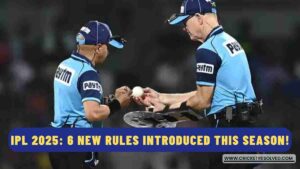
A set of rules governs every sport, including our favourite, cricket, to ensure fair play. To discourage players from chucking, one of the rigorous rules in international cricket limits bowling actions.
In cricket, chucking is an illegal action that results in an illegitimate delivery. Here’s all you need to know about chuking and its illegality in cricket.
Chucking in Cricket
Chucking is generally referred to as throwing a ball, and it occurs when the bowler straightens his arm while throwing the ball. The conduct is prohibited, and the ball is regarded as illegitimate.
The prohibition on chucking refers to bending the arm at the elbow. The ICC recently formalised the extent of arm flexion, which allows flexing the elbow to a maximum of 15 degrees.
If a bowler is caught throwing a ball, the umpire calls a no-ball and summons the player for a suspected throwing motion. In order to generate velocity for a ball while bowling, the shoulder must rotate. As a result, bowlers in international cricket should only straighten their elbow joint 15 degrees while delivering the ball.
The ICC’s rules apply when the bowling arm passes above shoulder height and releases the ball. The 15-degree limit takes into account the natural flexing of the elbow that occurs during a legal delivery.
Also Read | 15+ Types of No Ball in Cricket that You Should Know!
Illegality of Chucking
Cricket does not allow chucking since it gives the bowler an unfair advantage. When a bowler straightens his arm while delivering the ball, he gains an unfair advantage in terms of the pace and twists of the ball. The advantage of chucking is more widespread among spinners than fast bowlers since it allows them to generate more revolutions on the ball, resulting in more spin.
In cricket, the charge of chucking or throwing is serious and contentious. If a player is suspected of throwing, he is unable to play the game efficiently.
Typically, the umpire will use his cricket experience and his naked eye to determine if a player has engaged in an illegal action like tossing. If a bowler is accused of chucking after receiving only one warning, he is immediately suspended, and the umpire sends a complaint to the match referee after the match.
The player is then tested at an ICC-approved testing facility. The test evaluates the bowler’s action and measures the elbow bend during the action.
Before being allowed to play in a game, the bowler must adjust his bowling motion and pass another test. If a player is unable to adjust his action, he may be banned from bowling.
Off-spinners, in general, are more likely to be called for throwing during a front-on approach because their elbow gets in front of their wrist while releasing the ball. There have, however, been a few exceptions to this rule of throwing.
Also Read | Wrist Spin vs Finger Spin: The Art of Spin Bowling
The protocol for suspected chucking is as follows:
- The umpire first calls a No Ball and informs another umpire of the reason for such a call.
- The striker-side umpire’s primary responsibility is to judge the fairness of the bowling motion and signal a no ball. However, the umpire at the bowler’s end has the authority to call a no ball.
- After a no ball is called for a suspicious action, the umpire at the bowler’s end issues the first and final warning to the bowler. He then tells the bowling side captain as well as the batsmen about the incident.
- A bowler who has been cautioned for throwing may continue to bowl as long as he is not called out again in the same innings for the illegal bowling action.
- If the umpires suspect another unlawful bowling motion, they might issue a no ball call. The player is then immediately suspended for the remainder of the inning. The umpires also notify the two batsmen and the bowling side captain about the incident.
- Another bowler completes that over but is not permitted to bowl in the next.
- Following the contest, both umpires file a report with the match referee and notify the ICC and cricket bodies of the illegal bowling action. Action is taken against the bowler, the captain, or perhaps the entire team.
Also Read | The Role of a Match Referee in Cricket
Cricketers Accused of Chuking in International Cricket
Pakistan’s fast bowler Shoaib Akhtar, Sri Lanka’s off-spinner Muttiah Muralitharan, India’s off-spinner Harbhajan Singh, and the West Indies’ mystery spinner Sunil Narine are among the cricketers who were accused of chucking.
Final Thoughts
It is debatable whether or not chucking will be legalised in the future. The rules appear to be biased against bowlers, and many believe that the adoption of rules such as Free-Hit, Super-Sub, and Powerplay would give bowlers an advantage.
For example, legalising chuking for one or two deliveries per over might add additional colour to the game. Furthermore, fast bowlers and spinners can get extra speed and spin, which can work in their favour and shift the game when under pressure.






